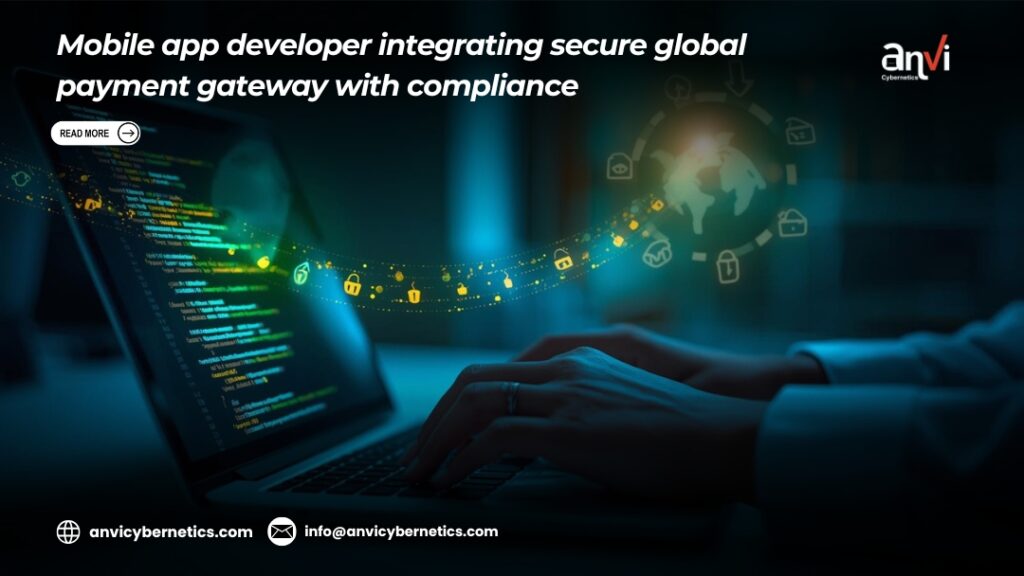
Payment Integrations & Global Compliance: From PCI to PSD2
Introduction
Modern mobile apps aren’t just tools — they’re commerce platforms. Whether booking a flight, subscribing to a SaaS, or ordering coffee, users expect frictionless, secure, and compliant payments within seconds.
Behind this simplicity lies a complex web of regulations, encryption standards, and cross-border compliance obligations. For developers, understanding this ecosystem is critical: one compliance failure or insecure transaction can derail reputation and revenue overnight.
This blog breaks down how to architect secure payment integrations while staying compliant with PCI DSS, PSD2, GDPR, and other international frameworks — plus practical steps for modern app development teams.
The New Era of In-App Payments
Over 75% of digital transactions globally now happen via mobile. As digital wallets, QR-based payments, and open banking APIs expand, businesses are under pressure to balance speed, compliance, and user trust.
Key drivers of modern payment design:
Understanding the Core Compliance Landscape
Payment integration doesn’t happen in a legal vacuum. Three frameworks dominate the global landscape:
- PCI DSS (Payment Card Industry Data Security Standard)
A global standard governing how organizations handle cardholder data.
It enforces:
- Secure data storage and transmission
- Network segmentation and encryption (TLS 1.2+)
- Regular penetration testing
- Strict access control and key management
Example:
If your app stores or processes card data directly, it must comply with PCI DSS Level 1.
Alternatively, delegating transactions to a PCI-compliant provider (like Stripe or Adyen) can drastically reduce your compliance scope.
- PSD2 (Payment Services Directive 2)
Europe’s PSD2 legislation fundamentally reshaped how financial transactions are authorized.
It mandates:
- Strong Customer Authentication (SCA) — multi-factor authentication for electronic payments.
- Open Banking APIs — enabling third-party apps to initiate and verify transactions with user consent.
- Fraud monitoring and transaction transparency.
For mobile developers, this means implementing flows that balance UX and compliance: biometrics, dynamic linking of payment data, and secure redirection for authentication.
- Global Data Protection Laws (GDPR, CCPA, PDPA, etc.)
Any payment involves user data — which falls under privacy regulations.
Compliance requires:
- Explicit consent before storing identifiers.
- Clear data-processing policies.
- Secure transfer under frameworks like Standard Contractual Clauses (SCCs).
The Architecture of Secure Payment Integrations
When building compliant payment systems, think layers — each layer handling security, logic, and compliance responsibilities.
- Payment Gateway Integration Layer
This layer connects your mobile app to a payment processor or acquirer.
Examples: Stripe, Razorpay, PayPal Braintree, Adyen, WorldPay.
Best Practices:
- Always use the gateway’s native mobile SDKs to ensure PCI compliance.
- Tokenize card data before transmission — your servers should never see raw PAN (Primary Account Numbers).
- Enable 3-D Secure 2.0 (3DS2) for strong authentication.
- Backend Server Layer
Handles business logic and communication with APIs.
- Store only transaction references, never raw payment data.
- Implement role-based access and HMAC signature verification for requests.
- Log all transaction events securely for auditing (compliance requires traceability).
- Security & Compliance Layer
Involves encryption, monitoring, and policy enforcement:
- Use AES-256 encryption for data at rest.
- Use TLS 1.3 for all data in transit.
- Rotate encryption keys frequently (AWS KMS or GCP KMS).
- Maintain real-time monitoring dashboards for anomaly detection.
Tokenization: The Cornerstone of Payment Security
Tokenization replaces sensitive card details with unique tokens that are meaningless outside the system.
When a user makes a payment, their card number is exchanged for a token by the gateway. This token is then used for future transactions, subscriptions, or refunds — without exposing real data.
Why it matters:
- Eliminates direct exposure to sensitive data.
- Reduces PCI scope.
- Enables secure “one-click” payments.
Example:
Apple Pay and Google Pay rely heavily on network tokenization, meaning the device never transmits the actual card number — only a hardware-bound token.
Strong Customer Authentication (SCA) & UX Balance
PSD2’s SCA requires two of the following three elements for electronic payments:
- Something the user knows (PIN, password).
- Something they have (mobile device, OTP).
- Something they are (biometrics).
Mobile Optimization Tips:
- Integrate biometric APIs (Face ID, Touch ID).
- Use frictionless 3DS2 flows where transaction risk is low.
- Cache consent tokens securely for recurring payments.
Done right, users barely notice authentication layers — but fraudsters do.
Cross-Border & Multi-Currency Considerations
Global apps face additional challenges:
- Different regional regulations (RBI, MAS, FCA, FinCEN).
- Currency conversion and foreign exchange risk.
- Local payment preferences (e.g., iDEAL, UPI, SEPA, Klarna).
Key Strategies:
- Use gateways with global settlement support (Stripe, Adyen, Checkout.com).
- Store currency metadata and fees transparently.
- Follow data localization laws — e.g., India’s RBI mandates that all transaction data be stored within national borders.
Fraud Prevention & Risk Management
Payment compliance goes hand-in-hand with fraud mitigation.
A robust fraud prevention framework should combine:
- Machine Learning Models: Real-time scoring of risk based on device, location, and user behavior.
- Velocity Checks: Limit the number of transactions per card or IP.
- Behavioral Biometrics: Detect suspicious activity patterns.
- Blacklists & Whitelists: Block known fraudulent BINs or regions.
Integrate these into your backend using APIs from providers like Sift, Riskified, or FraudLabs Pro.
Testing & Certification
Payment systems must undergo compliance certification before going live.
Compliance Test | Purpose | Frequency |
PCI DSS Self-Assessment (SAQ-A or SAQ-D) | Validate PCI adherence | Annual |
Penetration Testing | Detect vulnerabilities | Quarterly |
3DS2 Certification | Ensure PSD2 compliance | Before go-live |
Audit Logging Verification | Traceability & accountability | Continuous |
Mobile-Specific Payment Security Practices
Mobile apps require additional security controls:
- Secure Storage
Never store card data or keys in plain text.
Use Keychain (iOS) or Keystore (Android) for credential storage.
- Device Integrity
Implement root/jailbreak detection to block high-risk devices.
- Network Security
Apply certificate pinning to prevent man-in-the-middle (MITM) attacks.
- Obfuscation
Use code obfuscation tools to protect SDK keys and logic from reverse engineering.
- Secure Logging
Avoid logging sensitive information, even during debugging.
The Role of APIs & Webhooks
Modern payment systems rely heavily on APIs and webhooks for transaction events.
Best Practices:
- Authenticate all API requests using OAuth 2.0 or HMAC signatures.
- Verify webhook authenticity using secret keys.
- Retry webhook events idempotently to avoid double charging.
APIs must be rate-limited and monitored to prevent abuse or DoS attacks.
Compliance Across Key Regions
Region | Primary Regulation | Focus Area |
North America | PCI DSS, GLBA | Card data protection & encryption |
European Union | PSD2, GDPR | SCA, user consent, open banking |
Asia-Pacific | RBI, PDPA, MAS, PCI DSS | Data localization & multi-currency |
Middle East & Africa | NESA, SADAD, PCI DSS | Fraud prevention & KYC |
For global apps, map regulatory equivalences — many frameworks share core principles even if terminology differs.
Governance, Reporting & Continuous Monitoring
Compliance is not a checkbox; it’s an ongoing process.
What to Monitor:
- Failed authentication attempts (possible fraud indicators).
- API request anomalies.
- Latency and transaction timeouts.
- Policy drift — expired certificates or outdated encryption libraries.
Integrate dashboards using Prometheus, Grafana, or cloud-native monitoring tools for continuous compliance visibility.
Governance Tip:
Establish a Payment Compliance Matrix — linking every feature (e.g., recurring billing) to the standards it touches (PCI DSS §3.2, PSD2 Art. 97).
Promotional Spotlight
Payment integration isn’t just a technical add-on — it’s a trust layer.
At Anvi Cybernetics, we help organizations build and scale secure, globally compliant payment architectures that meet PCI DSS, PSD2, and data-protection requirements from day one.
Our mobile teams design tokenized payment flows, encrypted SDK integrations, and multi-region settlement systems that pass compliance audits without friction — enabling you to focus on growth, not red tape.
👉 Explore our Mobile App Development Services
Conclusion
Building payment integrations for global audiences requires technical precision, legal awareness, and UX empathy.
PCI DSS, PSD2, and regional data laws are more than checklists — they define the foundation of digital trust.
When done right, compliant payment systems deliver:
✅ Faster approvals
✅ Reduced fraud
✅ Seamless user experience
✅ Confidence from partners and regulators
As fintech, e-commerce, and super-apps converge, the winners will be those who treat compliance as an enabler, not a hurdle — combining speed, security, and transparency.




